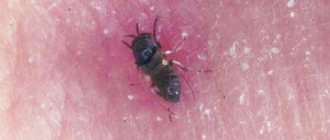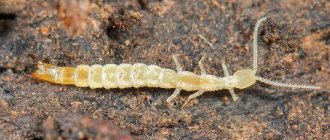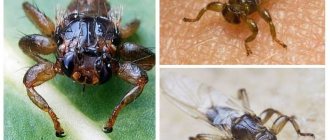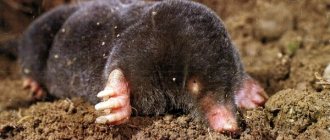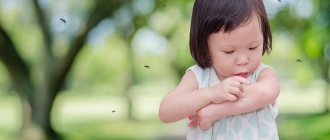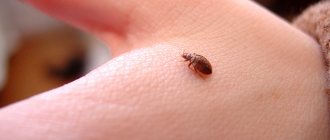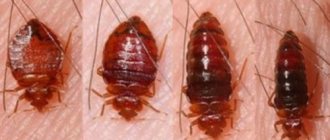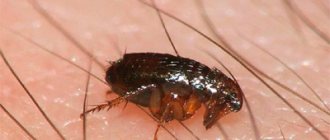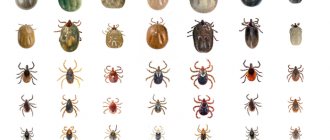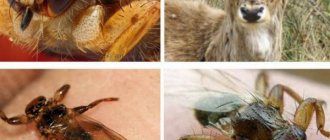The little midge is vile. Description of insects, habitat, characteristics of species, danger to humans. Can a midge bite? Why are blood-sucking bites dangerous? What actions need to be taken after a midge attack. How to prevent the development of serious consequences. Tips and tricks.
If you are planning to go to the forest to pick mushrooms, berries, or hunt, you need to be prepared for anything. You may have to spend the night in the forest, or you may meet a forest predator. In addition, there is a risk of being bitten by midges.
Below we will tell you what types of midges can attack you, what dangers can warn you when bitten, how to provide first aid and protect yourself with folk remedies and chemicals.
What is gnus
The midge is a small insect whose characteristics include the ability to mass attack a person or animal to consume blood. This species includes insects such as:
- mosquitoes;
- midges;
- horseflies;
- biting midges;
- mosquitoes.
In addition, the vile complex includes blood-sucking flies - tsetse, autumn flies. The presented species of parasites are found in different regions, regardless of climate - tundra, desert, temperate and tropical forests. In the photo you can see what they look like.
The maximum number of aggressive midges is concentrated in Siberia and Karelia. It is in these regions that the reason for the extinction of farm livestock (in the number of many thousands) and the cessation of logging-type enterprises lies in small blood-sucking insects.
Comparative table of remedies for midges
| Photo | Product | Type | How does it work | Price |
| Dynatrap Ultralight Insect and Mosquito Trap | CO2 trap | Lures with UV radiation and CO2, sucks insects inside and they die from dehydration | $34.00 | |
| Repel 100 Insect Repellent | DEET repellent | Protects up to 10 hours | ~$5.59 | |
| Sawyer Products Premium Insect Repellent with 20% Picaridin | Picaridin repellent | Protects up to 8 hours | ~$8.88 | |
| Sawyer Products Premium Permethrin Clothing Insect Repellent | Repellent spray for clothing | Apply to clothing, tents, bags, backpacks, hammocks, outdoor furniture and mosquito nets | ~$14.71 | |
| Coghlan's Bug Jacket | net | Protects hands, body and head | ~$9.50 | |
| No See Um Headnet | net | Protects your head | ~$3.17 | |
| Coghlan's Bug Pants | net | Protects feet | ~$9.51 |
Mosquito
The mosquito is one of the most common insects, which are classified as blood-sucking insects. Their number is more than 3 thousand species. The favorite places of mosquitoes are places characterized by high levels of humidity, as well as areas where there are stagnant bodies of water.
Such conditions are perfect for female mosquitoes to lay eggs, as well as for the full and unhindered development of their offspring.
Mosquito activity begins in May and lasts until September-October. Since the larvae of these pests are able to tolerate winter cold well, they can easily continue to actively develop and reproduce with the onset of spring.
Male mosquitoes eat plant foods, but females cannot reproduce without blood. Note that this type of insect is a carrier of dangerous infections, including yellow fever and malaria.
Midge
The midge is a small midge, characterized by high numbers. The taiga region alone has more than 1.9 thousand species of midges. Midges develop within an aquatic environment, which is why they are not found in dry, desert areas.
Most often, midges accumulate near open bodies of water, swampy meadows, and forests. It is almost impossible to find midges in well-ventilated areas and dry climates.
In appearance, the midge is a small parasite whose body length does not exceed four to five millimeters. Females eat human or animal blood.
When bitten, the skin is gnawed, which causes the person to experience rather unpleasant painful sensations and swelling may occur. Swelling as a result of a bite can be observed for several days. Moreover, bites are often accompanied by an allergic reaction.
The blood-sucking pest can act as a carrier of diseases that lead to death - plague, anthrax, tularemia.
Horseflies
Today, more than 5 thousand species of blood-sucking parasites such as horse flies are known, and 500 are found in Russia. For habitat they choose fresh water bodies, forests, and fields. Most often, they accumulate in large quantities in places where cattle graze.
The most common types of horseflies are parasites such as lacewings, rainflies, and bullflies.
In appearance, the horsefly resembles a large fly. The bite is carried out through a proboscis, with which the parasite pierces the skin of people or warm-blooded animals, while it injects a substance that stops blood clotting.
As a result, the wound after the bite is accompanied by prolonged pain and bleeding. Severe swelling, redness, and burning are also observed.
Mokretsy
Midges are small mosquitoes, their length reaches no more than 1-4 millimeters. In total, there are approximately 4 thousand species of biting midges, 500 of them live in Russia.
The female lays eggs and offspring on top of leaves and stems that grow from moist soil, sand, in forests, and near the shores of reservoirs (both fresh and salt). Both sexes of insects consume the blood of humans, a warm-blooded animal, as food.
When bitten, a substance with toxic components is injected, which causes the victim to experience severe allergies, pain, itching, and burning.
Mosquitoes
The mosquito is another species of midge that lives in tropical and subtropical climates, but is very rarely found in temperate climates. They are small in size, approximately 3-4 millimeters in length. They are characterized by slow movement and fly silently. Activation takes place at night.
Male mosquitoes consume plant nectar, but females must receive blood to be able to lay eggs.
A mosquito bite is accompanied by symptoms such as burning, itching, rashes, and painful pustules appear.
Varieties
More detailed information about the different categories of insects that are included in the group “gnuses” is given below.
Mosquitoes
When the question arises about what a midge is, the very first species that comes to mind is mosquitoes. The most dangerous among them are females, since they are the ones who strive to drink the blood of warm-blooded animals, while males are able to make do with plant sap.
Mosquitoes can feed on the blood of a person who is suffering from an infectious disease, and when they bite another person, they can introduce the resulting pathogen of this disease into his blood through the saliva that they secrete. Therefore, such vileness is especially dangerous. A photo of the mosquito is shown below.
This species of midge has 4 stages of development: egg, larva, pupa and adult insect. It is the last stage that poses a danger to warm-blooded animals, since it is this stage that shows interest in someone else’s blood.
A female mosquito can live up to 40 days.
The table below shows the main types of mosquitoes, as well as their habitats.
| Species name | Habitat |
| Squeaker mosquito | Lives everywhere. |
| Kusaka two-lane | It lives mainly in forest areas of the Tundra. |
| Malaria vulgaris | Europe (except Tundra). |
Horseflies
The largest among all gnats, reaching up to 30 mm in size. They have huge, bright eyes and, despite their name, they have excellent eyesight. Like mosquitoes, only females drink the blood of warm-blooded mosquitoes. They are most often found in hot seasons, when there is muggy weather and an abundance of sun.
Horseflies bite painfully, and swelling may occur, since their saliva contains substances that have a bad effect on the body of a warm-blooded animal. The stages of development are the same as those of mosquitoes.
Photo of horsefly:
The table below shows the main types of horseflies, as well as their habitats.
| Species name | Habitat |
| Deer | Found everywhere |
| Midday | This vile species is often found in Taiga or in the European part of the Russian Federation |
| Forest lacewing | Eurasia |
| Ordinary raincoat | Eurasia, Africa, North America |
Midge
A very unpleasant type of midge that quietly injects an anesthetic substance, thanks to which the warm-blooded midge does not notice the bite, but after the midge gets drunk, the bite site begins to burn, the pain is much stronger than from other types of midge.
The table below shows the main types of midges, as well as their habitats.
| Species name | Habitat |
| Odagmia spotted | Europe, Siberia |
| River | Europe, Siberia |
Mokrets
The smallest of all gnats. May be less than 1 mm in size. They are very similar to midges in appearance, so they are often confused.
Mostly found are the Burning Midge. It lives in places with high humidity, near ponds or large puddles. Often found in swamps. It bites very painfully, the bite site burns severely. Distributed in areas outside tropical Eurasia.
Blood-sucking flies
Blood-sucking flies live in the North and other regions. In appearance they resemble an ordinary housefly, but they use animal blood as food. Among the most common varieties is the autumn fly.
The parasite's oral apparatus has a special proboscis, distinguished by the presence of sharp serrations, with the help of which skin is torn off and blood is consumed. When a fly bites, it releases poison, which poses a risk of severe allergic reactions, itching, burning, and infection.
Both males and females consume blood. They can carry such dangerous diseases as tularemia, anthrax - depending on the species. their activity is observed from September to October.
The approximate lifespan of midges depends on the species and ranges from 3 days (midge) to 12 weeks (mosquito).
How does midge reproduce?
How the midge reproduces depends on its species diversity. Insects related to midges can reproduce:
- In still water
- Soil
- Detritus
- excrement
- Organic waste
- Rodent burrows
- Birds' nests
- In grass
- In manure
The midge is most active in the summer, but the period of mass emergence may vary among different insect species. For example, in mosquitoes and midges in the Central region of Russia, it occurs continuously from April-May to October, in fireworts - in early autumn, in deer bloodsuckers - from August to mid-October.
How long a particular type of midge lives depends again on its type:
- Mosquitoes – ≈ 20-120 days
- Midge – ≈ 3-90 days.
- Midlings - ≈ 14-50 days.
- Horseflies – ≈ 4-30 days
- Burner flies – ≈ 1-7 days.
Here are the approximate life spans of flying, biting insects. Before this, each insect spends some time in the larval stage, and this can vary more significantly - from 1-3 months for mosquitoes, to 1-6.5 years for horse flies. Also, some types of insects are able to temporarily slow down their development if environmental conditions are not the most suitable, for example, if they hatched with the onset of cold weather and understand that the conditions will not allow them to develop normally. Growth is then delayed until next spring.
Consequences of a vile attack
These types of insects bite every exposed part on the body. Most often, they pay attention to the arms, legs, and face. Initially, a person will not feel any pain, since the vile saliva contains anesthetic substances.
After this, the victim experiences the following symptoms (table):
| Type of symptom | How it manifests itself |
| Primary symptoms | Severe burning and itching Redness at the site of the bite Pinpoint wounds are located in a chaotic manner (even a detailed examination does not reveal the possibility of a midge bite) Swelling of tissues (in case of a midge bite near the eyes, there is a risk of swelling of the entire face) The appearance of cancer, blisters in the affected areas |
| General symptoms | Enlarged lymph nodes Increase in temperature (up to 39 degrees) Change in blood pressure Increased heart rate The appearance of purulent inflammation on the skin |
Allergic reactions to midge bites occur due to the fact that saliva contains hemolyzing substances of a protein nature. Children may experience more severe initial symptoms than adults.
This can be explained as follows: when itching occurs, children try to remove the symptom by scratching. Because of this, an unpleasant result occurs in the form of increased swelling - the wound becomes infected with pathogenic microbes, which leads to a long healing process of the skin.
Rarely, the most dangerous consequence of a midge bite may occur - anaphylactic shock. Harm also manifests itself in the risk of being harmed by a blood-sucking insect that carries a dangerous infection.
The midge was the cause of the plague epidemic no less than the rat. The risk of infection is small, but still, it exists if you consume the blood of a sick animal, and then a person.
What do bites usually look like?
It is interesting to know how and with what the midge bites a person. So that we may not even realize that we were bitten by it. Midges bite with a mouthpart consisting of a fleshy membrane. There are “knives” inside it that tear the skin. Upon contact with the skin, the pest begins to inject a special substance that creates an analgesic effect. The insect bites off a fragment of the outer layer of the epithelium.
The midge bites in two enlarged photos:
Afterwards, salivary residues are observed on the formed wound, which are highly toxic and pose a serious health hazard. At the very least, swelling forms on the skin, characterized by itching and burning. In the worst case, an allergy develops. Sometimes the temperature rises, blood pressure decreases, and a rapid heartbeat is noted. A small rash forms on the dermis.
What do the signs of midge bites on the skin of an adult look like in the photo:
Scratching the formed swelling poses a great threat to health. In this situation, a significant wound appears on the affected area, capable of bleeding and fester. In severe cases, dark-colored scabs form on the dermis. Incessant itching, which provokes scratching, becomes a factor of infection by pathogenic microflora. There is a high probability of such development if a midge has bitten a child.
The photo shows characteristic symptoms for identifying midge bites in children:
midge bite
The bites of such insects pose a serious danger to people and animals. Their saliva contains toxic components, which, when released into the victim’s blood, provoke severe itching, burning, inflammation and redness of the skin tissue.
It is worth remembering that a bite can cause allergic reactions, which can lead to complications. In such cases, the development of Quincke's edema and anaphylactic shock is possible.
Therefore, insect attacks should be taken seriously and the necessary measures should be taken to prevent complications that pose a danger not only to human health, but also to life.
Elimination of swelling in the eyes
There may be situations where the midge bites in the eye area. This results in swelling of the upper eyelid, but it is also possible for the swelling to spread down the entire face. In addition to swelling, a person is bothered by severe pain, it seems that there is a foreign body in the eye, and the eye is very watery.
When a person experiences these symptoms, the following measures should be taken:
- Rinse the affected area with plenty of cold water.
- Apply a cold compress.
- Take any antihistamine, for example, Suprastin, Claritin, Fenistil drops, be sure to follow the dosage.
- Use eyelid ointment.
Use the ointment with extreme caution so that the drug does not get into the eye or mucous membranes; apply a thin layer to the eyelid. You can use ointments such as Nezulin, Fenistil, Psilo-balm.
If the swelling is too severe, your doctor will likely recommend using hormonal ointments, such as hydrocortisone or prednisolone. But remember, in this case you cannot self-medicate, since you can harm yourself even more; seeing a doctor is a mandatory procedure.
When swelling is accompanied by severe pain, you can take painkillers. It is recommended to take paracetamol or ibuprofen, as they have an anti-inflammatory effect.
Remember that it is prohibited to use creams, ointments, solutions for wiping or compresses that contain alcohol or vinegar, since these substances penetrate through thin skin, which leads to irritation and aggravates the situation.
How to avoid midge bites
Midges bite unnoticed and it is not always possible to feel their bite, so if you know that you are going to travel to nature or to the country, be sure to take precautions:
- Don't wear perfume. This attracts midges.
- Dress to show as little skin as possible.
- It is better to wear clothes made from natural fabrics.
- Apply products that repel midges. Please read the instructions before applying.
- The smell of food also attracts pests. When you sit down to eat, be sure to cover as much of your body as possible with clothing.
If you live in an apartment or house, you can also become victims of midges.
This is where electric fumigators will come to your aid.
If you take all protective measures, then you will not be afraid of any pests and the summer will pass 100%.
Treatment of a mosquito bite
In order to prevent complications and relieve unpleasant symptoms from bites, treatment should be started immediately. Quite effective folk remedies that help reduce swelling, relieve itching, burning and pain.
To treat the affected area, you can prepare the following solutions:
- Mix ammonia and water in equal quantities.
- Take 1 glass of water and add ½ teaspoon of soda, stir thoroughly until completely dissolved.
- Take a glass of water and add ½ teaspoon each of salt and soda, stir thoroughly until completely dissolved.
These solutions should be used as follows: moisten cotton wool or a bandage in the solution, then apply to the affected area for 10-15 minutes.
To get rid of wounds, you can use calendula tincture, onion or lemon juice, mint, parsley, plantain, dandelion leaves, crushed cabbage leaves, and potato juice.
Now you can buy special ointments, creams, gels, of which there is a wide range on sale. These products have anti-allergenic, anti-inflammatory, anti-edematous effects. They help relieve itching, swelling and redness.
These drugs include:
- Trimistin.
- Hydrocortisone.
- Fenistil gel.
- Psilobalm.
- Levomekol.
- Tetracycline.
When a child is attacked by midges, the affected area must be covered with a clean, sterile bandage. Since the wounds are very itchy, a child can scratch it, and this can lead to bacteria. Also, during a blood-sucking attack, it is recommended to take an antihistamine, for example, Tavegil, Suprastin, Claritin.
Remember that if you experience severe symptoms that cause discomfort or pain, be sure to consult a doctor. The specialist will give directions for the necessary tests and prescribe effective, and most importantly safe, treatment. There is always a risk of developing a severe allergic reaction.
What are the dangers of midge bites for humans?
After a midge bite, most people experience a standard reaction that lasts quite a long time, but when therapeutic measures are taken, it goes away without any consequences for the victim’s health. In some cases, an attack by this insect can cause such a dangerous phenomenon as an allergy, which, if the symptoms are ignored, untimely or improperly treated, can lead to death.
Normal reaction: how does it manifest itself, how long does it last?
Midges bite in all parts of the body without exception. They don't have favorite places. A bite from a midge can affect the leg, arm, face, stomach, and back. Most often, it is the limbs that are affected - the most exposed parts of the body. At the time of the attack, the victim does not feel any discomfort, because the saliva of these insects contains an anesthetic.
Severe redness, pain, itching, burning and swelling, in the center of which you can see a red dot, appear later. Depending on your immunity, the first signs may appear within 10–20 minutes or after a few days. Possible increase in body temperature.
The severity of the symptoms that appear after a child or adult is bitten by a midge depends on many factors:
- number of attacked insects;
- state of the immune system;
- age of the person bitten;
- predisposition to allergic reactions.
What causes this body reaction to the bite of this insect? Redness, swelling and acute pain are associated with the fact that midge saliva, in addition to the analgesic component, contains:
- an anticoagulant secretion that blocks the functioning of the coagulation system, so that the pest has time to feed on blood;
- a hemolytic toxic substance that causes redness and swelling of the skin;
- histamines;
- enzymes.
The swelling from a midge bite is much more extensive than from a mosquito bite, and accordingly, the pain is more pronounced. This is due to the fact that during an attack, the mosquito cuts the skin, injecting saliva into the wound, causing bleeding, while the mosquito pierces the flesh with a thin proboscis, sucking blood from a capillary vessel.
Manifestations of allergies
Enzymes contained in the saliva of these insects, if they enter the wound during a bite, can provoke the development of a severe allergic reaction—simulidotoxicosis. When, for example, the leg is swollen after an insect bite, the affected area itches, hurts and itches, but in general the condition of the bitten person is satisfactory - there is no need to worry, you just need to observe the victim. The following symptoms indicating the development of an allergy require immediate treatment measures:
- Severe itching, burning, intradermal hemorrhage, swelling and redness, tending to worsen.
- Signs of general intoxication of the body, appearing 3–5 hours after a midge attack: a sudden increase in body temperature to 38–39°C, severe chills, weakness, muscle, joint and headaches, impaired breathing and heart rhythm.
- Inflammation of the lymph nodes. The lymph nodes become inflamed after 5–8 hours, the time depends on the number of bites and the individual characteristics of the body. This condition can last up to 14 days.
As allergies develop, anaphylactic shock may occur. The listed symptoms cannot be ignored. In severe cases, inaction can cause the death of the victim. If one of the family members was bitten by a midge, after which he began to lose consciousness and become delirious, he must be immediately taken to the nearest medical facility. In this situation, every minute matters.
First aid for a tumor
In order to prevent re-infection, as well as to prevent inflammatory processes, after an attack by midges, the affected area must be treated. Antiseptic agents can eliminate severe itching.
But before you get rid of the itching, you should resort to the following actions:
- At the first stage, you should wash the wound under running water, you can use antibacterial soap.
- Redness indicates an inflammatory process; antiseptic agents should be used. This can include products that contain alcohol, calendula, or citrus juice. If the attack occurred in nature and it is not possible to use any drugs, at the first stage you can wash the wound with your own saliva.
- Swelling and puffiness must be eliminated with cold compresses and ice.
- Now there are a large number of ointments, balms, creams that can relieve swelling.
- You can also use tincture of valerian and motherwort to treat the affected areas.
If these actions do not bring results, be sure to contact a doctor who will prescribe effective treatment.
Eliminating symptoms
In a typical process, the sequence of changes is as follows: insect bite – rash – itching – scratching – infection – formation of a wound with an inflammatory process on the skin. A similar sequence of measures must be followed during therapy. Let's see what to do if you have allergies, itching, redness and swelling if you are bitten by midges.
Pain and burning
To eliminate pain and burning, the following algorithm should be used:
- We wash the top layer of the skin. filtered water with regular laundry soap;
- Dry the skin without rubbing.
- Press the affected areas with your fingers for 3-5 minutes.
- We treat with an antiseptic (water or alcohol).
- We drink an anesthetic and antiallergic drug.
Itching
If, due to itching after an attack, the victim begins to scratch the damaged area on the skin, the dermis is additionally subjected to trauma and inflammation, and infection penetrates into the wounds. This significantly aggravates the situation, so you need to know what to anoint such places with.
Here is information on how to treat, how to relieve itching and spots after the lesion. We eliminate discomfort with the help of effective folk remedies in the absence of contraindications:
- Onion porridge.
- Toothpaste with menthol.
- Compress made from mashed potatoes.
- Thick foam from laundry soap.
- Compress of crushed dandelion leaves, plantain, peppermint.
- Chatter on water with validol, vodka and vinegar. Add 1 tbsp to a glass of water. l. vodka and vinegar, and then 2 crushed validol tablets.
Rashes
Let's figure out what to smear the place with. There are effective remedies and compresses, but before that you need to take important steps:
- apply baking soda compresses to the affected area;
- use antihistamines;
- anoint the bite site with “Bepanten” or “Golden Star” balm.
Before using the ointment, like any other remedy for the treatment of gnat bites, you need to carefully study the contraindications.
How to get rid of a pest
There is no way to completely get rid of small blood suckers. These are inhabitants of wild nature who prefer areas near rivers and lakes, forests, fields, and the banks of swamps. But you can protect yourself from the attacks of these small pests.
If you are planning a trip to nature, where this blood-sucking midge most likely lives, you can use a special Antignus suit. Of course, you should use clothing that protects your body as much as possible.
This is a jacket with long sleeves and tight cuffs, a thick and tight collar, and tapered pants. To protect the head and faces, a hood and a mosquito net are used, but we all understand that such protective actions are relevant in the wild, and not in summer cottages and during outdoor recreation.
But in addition to clothing, which the midge cannot bite through, you can also use specialized products. When the holiday involves spending the night in a tent, a mosquito net is used, as well as specialized repellents. Nowadays you can buy a variety of repellents in the form of aerosols and creams.
Remember that when choosing a repellent, it is important to take into account what type of insect the drug is produced against. Also take into account age restrictions; special preparations are produced for children.
If we talk about the most popular products that have proven their effectiveness, it is worth noting Moskitol, Off, Taiga, Gardex, DEET.
Regarding folk remedies that make it possible to protect yourself from midges, one of the most effective is birch tar.
To do this, take birch tar and mix it with the same amount of sunflower oil, then use it as oil on open areas of the body. But remember that this product should be washed off with warm water 3-4 hours after application.
Quick facts about midges
- With the mass emergence of the midges and their frequent attacks, with each injection, insect saliva, which contains toxic substances, enters the human skin. A person’s reaction to a bite is individual: significant local, sometimes significantly general. Spreading. The gnus lives everywhere and can cause great trouble, as it is often not only the cause of allergic reactions, but also a carrier of many infectious diseases.
- As a result of the bites of these insects (mosquitoes, midges, midges, midges), some people suffer from so-called insect allergies. The reaction to the bite occurs within 6-12 hours and lasts up to two days. Recurrences of the reaction can continue without repeated insect bites for two months. Manifestations of midge bites are mainly local in nature (rash, swelling). In more severe cases, bronchospasm and laryngeal edema are noted. There is no anaphylactic shock from bloodsucking venom.
- During periods of mass emergence, insects behave very intrusively, entering the mouth and the external auditory canal, which causes very unpleasant sensations. If insects get into the ear, it is necessary to lay the victim on his side and pour a little warm water into the ear canal. After 1-2 minutes, the victim lies down on the other side, the insect that got into the ear comes out along with the water. If you cannot get rid of it in this way, you must contact a medical facility.
- Almost everyone loves outdoor recreation. It has a positive effect on health, allows you to enjoy beautiful scenery, have a good time with your family or be in the desired solitude. But these impressions can be greatly overshadowed by vileness. All people encounter it when they go out into nature, but not everyone knows what it is. What it is, what its varieties are, and what can be done if it bites is described below.
Herbs and oils
Natural products that are also absolutely safe are very effective in combating symptoms.
Let's look at the most effective recipes that use aloe juice, plantain, basil and other natural products:
- Aloe. Aloe is very useful; if you have this medicinal plant, rest assured that it will prevent negative reactions to blood-sucking bites. You should cut the leaf and apply aloe pulp to the affected area. You can also use the juice of the plant; to do this, soak a cotton pad or a piece of bandage in it and apply it to the bite.
- Basil. We all know that this herb brings a lot of benefits to the body when used as food, but it will also save you from unpleasant symptoms, relieve inflammation, and eliminate itching and burning. To do this, take a few leaves and grind them into a paste, then apply it to the wound.
- Plantain. Everyone has been familiar with this plant since childhood; it was considered the remedy that would cure any wound. It is worth saying that plantain is truly a unique plant because it has anti-inflammatory and antiseptic effects, and also accelerates the healing process. You should take a leaf, grind it to a paste and apply it to the wound.
- Essential oils. In order to relieve swelling and get rid of itching, you should use lavender or tea tree essential oil. It is enough to apply a few drops to the affected area of the body.
The best CO2 trap
Scientists have found that CO2 can be used, as in the case of mosquitoes, and to get rid of midges and midges. We chose the most budget option, which can cover up to 300 sq.ft. And you can even take it with you on a trip if you know that bloodsuckers pose a real threat at your destination.
Dynatrap Insect Trap
Dynatrap for $34.00 attracts midges with light, heat, CO2 and covers an area of up to 30 square meters. It works against midges, flies, sand gnats, midges, mosquitoes, and other flying insects, including wasps and beetles. Just like other traps, it lures insects with the warm light of a UV lamp, but the trap has an additional feature: it imitates human breathing! The latter is the result of the interaction of UV light, CO2 (simulating human respiration) and a special titanium dioxide covering the surface of the device.
What happens after? Attracted by light and “breathing,” the insect encounters a powerful but quiet fan, which, like a vacuum cleaner, sucks it into the cage forever and irrevocably. And there, inside a special compartment, all the midges die from dehydration.
Which repellents to choose: DEET or more gentle products?
In the USA, the most popular repellents are those based on DEET (known in Russia as “DEET”). The best-selling brand on American Amazon is Repel 100 Insect Repellent . Costs approximately $7.19. According to the manufacturer, one application to the skin will provide up to 10 hours of protection against insects.
On the one hand, many are afraid of overly powerful DEET repellents, but they are indispensable if you go to places infested with flying bloodsuckers (swamps, forests), hunting or fishing.
On the other hand, there are more gentle substances such as IR3535, which are also used to repel insects. But their effectiveness is much lower. Therefore, you will have to choose either an effective one or a more gentle one, but with a shorter lasting effect. If you have sensitive skin, consider the following products: with picaridin to protect the skin, and a special spray with permethrin for treating clothes.
The second most popular repellent on American Amazon is Sawyer Products Premium Insect Repellent with 20% Picaridin . This inexpensive yet effective $8.88 repellent is effective for up to 12 hours against mosquitoes and ticks and promises to provide up to 8 hours of protection against midge bites. Used worldwide since 1998 and most popular in Europe. It is safe for the whole family to use and will not damage clothing, bags, watches or synthetic fabrics. It is completely safe and has a pleasant citrus scent. If you need to use it together with sun cream, apply the cream first and only after 10 minutes apply the repellent.
How to turn an ordinary T-shirt or jacket into “special clothing for protection against midges”
Here is a special repellent for clothes with permethrin - Sawyer Permethrin Clothing Insect Repellent. It costs about $14.71 and although it is more expensive than other repellents, it provides protection for up to 6 weeks. The repellent is universal and will cope not only with midges, but also with mosquitoes, ticks and 55 other types of biting insects - which makes it an ideal option for both hiking and long forays into nature.
Permethrin is approved by the US Environmental Protection Agency (EPA), but just in case, keep the spray away from cats - it can negatively affect their nervous system. And the spray has been successfully protecting people from midges for many years: the uniforms of American army soldiers are treated with permethrin.
The repellent is applied directly to clothing and continues to work even after washing (can be washed 6 times). Unlike DEET, which can damage some fabrics and materials, permethrin can even be used on fabrics such as silk, as well as synthetic and waterproof fabrics (does not affect plastics or trims). That is why it can be sprayed not only on clothing, but also on the outside of tents, backpacks, hammocks, outdoor furniture and mosquito nets. Asthmatics should use the product with caution indoors.
Clothing to protect against midges and midges
To prevent bites, it is not enough to simply put mosquito nets on the windows and wear regular clothes with long sleeves and long pants - see what clothes we found specifically to protect against these “invisible creatures”.
Coghlan's Bug Jacket
This hooded jacket seems unsightly, but when it comes to protecting yourself, all questions of aesthetics fade into the background. It is made of a special fine mesh, has laces at the waist and cuffs and a convenient zipper at the neck. The jacket seals you in securely, but is also lightweight, breathable, and keeps you cool. Bug Jacket is not easy and has a high rating of 4.5 out of 5 stars. It’s not even that it’s quite budget-friendly (the price depends on the size and starts from $9.50), but it’s just that it’s helped many people organize their leisure time without getting stung.
And satisfied users share their life hacks:
- If possible, wear something with long sleeves under the jacket (the fabric is a little harsh to the body);
- put a hat on your head under the hood of your jacket;
- do not sit in a jacket near a fire and smoke with caution (sparks easily make holes in such a polyester jacket)
If you only need head protection, check out No See Um Headnet from the same brand for ~$3.17 . You also need to wear a hat under it - and the fit to the neck is no worse than that of a full-fledged jacket with a hood.
Coghlan's Bug Pants
Not only the upper half of the body needs protection, but also the lower half, because the legs are often bitten by mosquitoes, ticks, fleas and other insects. Coghlan's pants have the same characteristics as the jacket of the same name: they also have drawstrings at the waist and cuffs and keep you cool. Users say that this works, but if the pants are worn, for example, over shorts, then small gnats will be able to bite you if the mesh fabric fits tightly to the shins. Therefore, they advise purchasing Bug Pants a larger size. Price from $9.51
7 tips on how to protect yourself from midge and midge bites
- Remove vegetation from the house; bushes and trees, on the contrary, can be left. This will reduce the number of hiding places for insects and increase air flow. Mow your lawns on time.
- Install special mosquito nets on all windows, which have such a small mesh that even tiny insects cannot fly through. Additionally, hang a curtain made of light fabric on the door, and also hang a canopy made of fine mesh above the bed.
- Close the windows on the leeward side, they are very light, so it is difficult for them to fly against the wind.
- Install fans at home, this will reduce the heat and drive away small midges. They rarely bite if there is even a small air flow.
- Do not leave water running out of hoses after watering or washing your car. Try not to engage in such activities late in the evening, when insects are especially active.
- Pay attention to how they behave in your area relative to the lunar cycle; this species bites most actively in the few days after the full and new moon. Based on this, plan barbecues on days when their activity is minimal.
- Turn off street lights if possible: most midges are attracted to bright lights. Read here how to get rid of midges in flowers.
